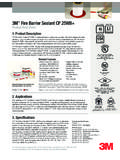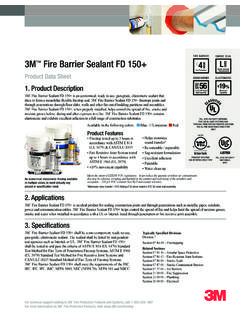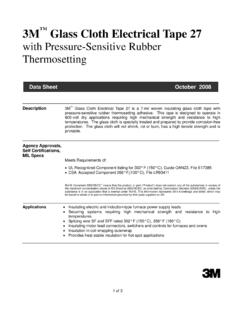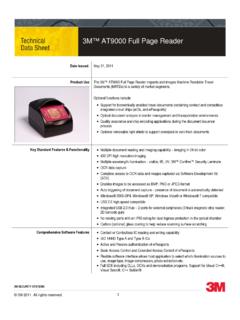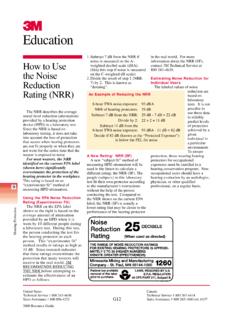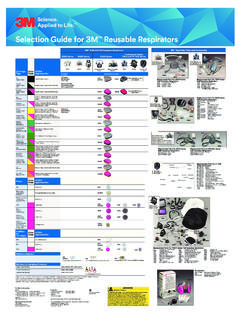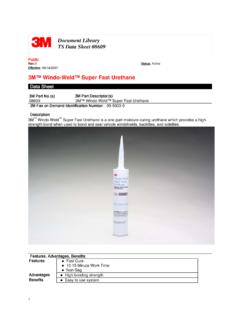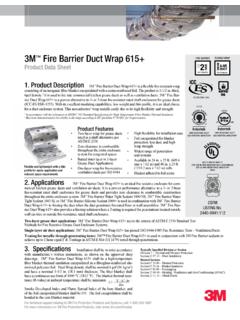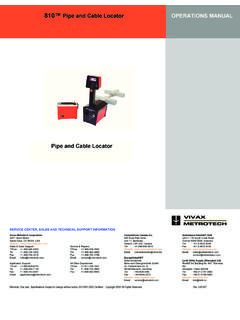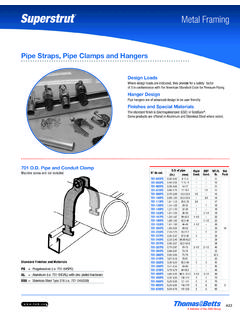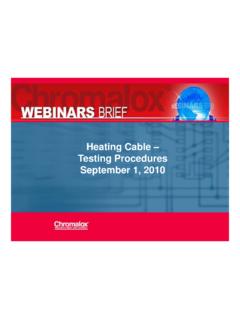Transcription of Dynatel 2273 Advanced Cable and Fault Locator
1 September 199978-8097-6517-1-BDynatel 2273 Advanced Cable andFault LocatorOperators ManualTABLE OF CONTENTSI ntroduction .. 2 Installing or Replacing the Batteries .. 2 Initial Receiver Configuration .. 3 Receiver Battery Test .. 3 Transmitter Battery Test .. 4 Using External DC Power and 5 Watt Output .. 4 Locating a Buried Cable .. 5 Transmitter Setup .. 5 Direct Connect Method .. 6 Dyna-Coupler Method .. 8 Induction Method .. 9 Receiver Setup .. 10 About Trace Modes .. 11 Selecting Passive Power Frequencies .. 12 Selecting Auxiliary Frequencies .. 12 Determining Cable Depth and Current .. 13 Using Current Indications During Locating .. 14 Locating Sheath Faults .. 15 Transmitter Setup .. 15 Receiver Setup.
2 15 Locating an Active Duct Probe (ADP) .. 17 Determining ADP Depth .. 17 Locating EMS Markers .. 18 Locating Markers while Tracing Cable Path .. 18 Locating Markers Using the Receiver .. 18 Toning Aerial Faults .. 19 Transmitter Setup .. 19 Receiver Setup .. 19 Cable or Pair Identification .. 20 Transmitter Setup .. 20 Cable Identification Receiver Setup .. 20 Pair Identification Receiver Setup .. 21 Optional Accessories .. 21 Technical Information .. 22 Page 1 INTRODUCTIONThe 3M Dynatel 2273 Advanced Cable and Fault Locator consists of aTransmitter and a Receiver for locating buried cables or Active DuctProbes (sondes). It also measures and pinpoints sheath faults in buriedcables and conductor faults in aerial cables. The Transmitter provides fourfrequencies to accommodate varying factors such as distance, Cable type,or soil conditions.
3 If desired, all four frequencies may be transmitted atonce. The Transmitter also provides a separate Tone function foridentifying cables and pairs. The Receiver provides four locating modes toaccomplish fast or difficult tracing and to pinpoint or verify a Receiver detects 50 or 60 Hz AC Power signals and also measures thesignal current in a Cable and displays its magnitude. The depth of buriedcables or sondes may also be : For more detailed locating instructions and Advanced locatingtechniques, ask your 3M sales representative or call 800/426-8688 for afree publication called Cable and Pipe Locating OR REPLACING THE BATTERIESB attery Disposal: Since regulations vary, consult applicable regulationsor authorities before 'C'cells6 'AA'cellsCAUTION!Do not connect batteries improperly, charge or dispose of in may leak or explode and cause personal injury.
4 Alwaysremove batteries when storing the 2 INITIAL RECEIVER CONFIGURATIOND isplay depth units (inches, feet and inches, or centimeters) may bechanged while holding and pressing . For each press, one ofthree units will display. To change the passive Power frequency, press andhold then press to toggle between 50 or 60 Hz as displayed inthe lower left corner of the change the Null bar graph display mode, press and hold thenpress to toggle between normal Null bar graph display (Null flag willflash) and inverse Null bar graph display (Null flag is on solid). See sectionAbout Trace Modes (Page 11) for further 3 RECEIVER BATTERY TESTThe Receiver batteries are tested for two seconds every time the unit isturned on. The time interval can be extended by pressing and holding.
5 During the battery test, the bar graph should extend to the right of thebattery level mark, otherwise replace the : When batteries are low, the battery test indicator will TestIndicatorBattery LevelMarkTRANSMITTER BATTERY TESTTo test the Batteries, press and hold . Listen to the tone and watchthe display. solid tone and 'OK' indicates batteries good; beeping tone and 'LO' indicates batteries low; no tone and '- -' indicates replace : The battery test indicates battery condition for normal outputlevels. If the unit resets when the high output level is selected, use thenormal output level or replace the EXTERNAL DC POWER AND 5 WATT OUTPUTIf the unit has the option A, the Transmitter can be operated from anexternal 12V DC source as well as its internal batteries.
6 Use the suppliedcigarette lighter adapter Cable to connect the DC power from a vehicle'sbattery source to the Transmitter's external power jack located next to theoutput : The internal batteries will not be recharged with external Watt OutputAn external DC source is required for 5 watt output. To select 5 wattoperation, press once for high output (3W) and again for 5 wattoperation. The High Output flag will turn on for 3W and flash for 4 LOCATING A BURIED CABLET ransmitter SetupNote: Key descriptions can be found inside the Transmitter a battery test and then connect the Transmitter using one of thethree methods below to put tracing signal on a !Voltage greater than 240 volts will damage equipment and causepersonal injury and death. Make all direct test connections beforeturning on the Transmitter.
7 Then activate the Transmitter in the Ohmsmode and check the display for voltage readings. Follow standardprocedures for reducing the !Potential for electrical shock exists when handling connecting cableswhile the Transmitter is in the TRACE, Fault or TONE modes. Turnthe Transmitter off before handling connecting 5 Make sure the Transmitter is off. Plug the direct connect Cable into thefront panel jack. Connect the Black clip to the ground rod. Place theground rod in the earth perpendicular to the suspected Cable path. Ifnecessary, extend the black lead with the Ground Extension Cable . Next,remove the ground bonding and attach the Red clip to the to turn the Transmitter on in the Ohms mode . It willmeasure the continuity of the Cable under test.
8 The results are displayed inohms and as a tone (solid tone = good ground; beeping tone = usableground; no tone = poor or no ground).Note: In the ohms mode, the Transmitter can detect voltage as well as ohms. If alow voltage is detected, the display will alternate between displaying ohms andvolts. When displaying ohms, the flag over the will be visible. When displayingvolts, the flag over the 'V' will be visible. When the voltage magnitude is sufficientto impair the accuracy of the ohms measurement, only voltage will be displayed. Ifthe voltage is AC, a sine wave will be visible on the display. If a high ACvoltage is detected, a rapid beeping tone will be : Never attach or remove the direct connect Cable from the Transmitter frontpanel jack while the red and black clips are connected to a Connect MethodPage 6 Press to select Trace mode.
9 Press again to select one or all of thefour frequencies. The display will alternate between displaying theselected frequency and the output signal current. It is best to choose thelowest frequency for direct connect with far-end ground and a highfrequency for direct connect with no far-end to select high output level for longer tracing distances anddeep setup is finished, now go to LOCATING A BURIEDCABLE - RECEIVER SETUP (Page 10).Page 7 Dyna-Coupler MethodCable PathConnect the Dyna-Coupler to the Transmitter front panel jack using thecoupler the Dyna-Coupler around the Cable below any bonds just before thecable enters the earth. The jaws of the coupler must fully to turn Transmitter on. Press again to select 8 kHz, 33kHz, or200 high output level by pressing.
10 Transmitter setup is finished, now go to LOCATING A BURIED Cable - Receiver Setup (Page 10).Page 8 Induction MethodPlace the transmitter on the ground over the target Cable with the lid hingein line with the Cable path. Press to turn the Transmitter again to select either 33 kHz or 200 kHz. For greater tracing range,select high output level by pressing .Note: If the Receiver is less than 50 feet from the Transmitter, it can pickup signal through the air. For best results, keep the Receiver away fromthe Transmitter by at least that setup is finished, now go to LOCATING A BURIED Cable - RECEIVER SETUP (PAGE 10).Page 9 LOCATING A BURIED CABLER eceiver SetupNote: Key descriptions can be found on the side of the to turn the Receiver to select the 50/60 Hz power frequency (see section onSelecting Passive Power Frequencies on Page 12) for passive locating;otherwise, select the same frequency as the to adjust the speaker volume as needed: off, normal, high, orhigh-expanded.

